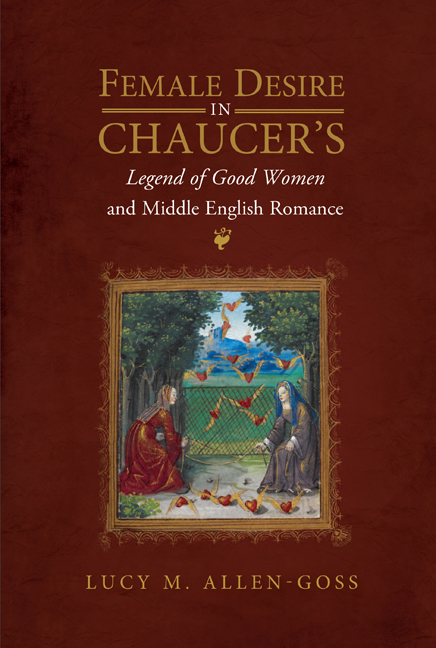Book contents
- Frontmatter
- Contents
- Acknowledgements
- Abbreviations
- Author’s Note
- Introduction: The Origins of Female Desire
- 1 The Silencing of Female Desire in the ‘Legend of Philomela’
- 2 The Traumatised Narrative of the Alliterative Morte Arthure
- 3 ‘As Matter Appetiteth Form’: Desire and Reciprocation in the ‘Legend of Hipsiphyle and Medea’
- 4 Stony Femininity and the Limits of Desire in The Sowdone of Babylon
- 5 Veiled Interpretations and Architectures of Desire in the ‘Legend of Thisbe’ and the ‘Legend of Ariadne’
- 6 Opening Mechanisms, Enclosing Desire: The Erotic Aesthetics of Undo Your Door
- Conclusion: The Ends of Desire
- Bibliography
- Index
- GENDER IN THE MIDDLE AGES
6 - Opening Mechanisms, Enclosing Desire: The Erotic Aesthetics of Undo Your Door
Published online by Cambridge University Press: 16 September 2020
- Frontmatter
- Contents
- Acknowledgements
- Abbreviations
- Author’s Note
- Introduction: The Origins of Female Desire
- 1 The Silencing of Female Desire in the ‘Legend of Philomela’
- 2 The Traumatised Narrative of the Alliterative Morte Arthure
- 3 ‘As Matter Appetiteth Form’: Desire and Reciprocation in the ‘Legend of Hipsiphyle and Medea’
- 4 Stony Femininity and the Limits of Desire in The Sowdone of Babylon
- 5 Veiled Interpretations and Architectures of Desire in the ‘Legend of Thisbe’ and the ‘Legend of Ariadne’
- 6 Opening Mechanisms, Enclosing Desire: The Erotic Aesthetics of Undo Your Door
- Conclusion: The Ends of Desire
- Bibliography
- Index
- GENDER IN THE MIDDLE AGES
Summary
Few Middle English authors save Chaucer can claim so widespread a presence in the works of sixteenth-century authors as the anonymous creator of the late fifteenth-century romance Undo Your Door. The text was printed at least twice in the sixteenth century, survives in two different versions and is listed in the Day Book of John Dorne alongside other well-known romances. Spenser retells the tale in the Faerie Queene; Thomas Nashe knows it; Beaumont and Fletcher use its alternative title ‘Squire of Low Degree’ as an insulting epithet in their plays, and Shakespeare borrows its striking image of anagram-solving for Malvolio. Yet scholars have struggled with its chaotically amalgamated representations of romantic desire, taking refuge in the ascription of its popularity to its parodic undermining of an ‘outmoded’ genre steadily going out of fashion. Recent reconsiderations of romance as a genre and periodisation as a practice urge us to reconsider that reading, and to ask again what earlier readers found so compelling, so suggestively evocative, in Undo Your Door. I argue that the romance pointedly locates itself within a Chaucerian tradition of subversive writing, and that it layers together tropes and images associated with female desire, which we have seen operating in various texts and contexts earlier in this book. We see female sexuality represented as a transgressive yet creative force, which disrupts expectations of male–female sexual and erotic relations and assembles its own objects of desire from inanimate materials and from mechanisms disturbingly reminiscent of the objects medieval writers associated with same-sex desire and female autoerotic satisfaction. In this, the romance upends and dissects the paradigm of masculine authority and female passivity in both textual and sexual operations.
CRACKED COPIES: THE REPRODUCTIVE AESTHETICS OF UNDO YOUR DOOR
Undo Your Door has been widely interpreted as the last gasp of the medieval romance tradition, a retrospective parody of the genre that undermines the long-established tropes of chivalric masculinity and reproductive desire. Certainly, the characters are recognisable from earlier romances. There is the low-born hero who proves his worth as a knight; the jealous steward who arranges ham-fisted sabotage; the capricious father, who ultimately capitulates to his son-in-law; and, above all, the desired lady. Yet the plot that draws these familiar elements together is oddly out of joint.
- Type
- Chapter
- Information
- Publisher: Boydell & BrewerPrint publication year: 2020



